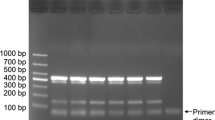Abstract
Until recently, no method was available to identify and quantify individual Fusarium species present within plant tissue. Specific DNA markers have been identified for the Fusarium species which are predominant components of the ’Fusarium ear blight complex’ (scab) and ’stem-base complex’ of cereals. Assays based upon the polymerase chain reaction (PCR) have been developed for detection of several of these fungi in DNA extracts from plant tissue. These assays have been refined to enable quantification of each species, allowing the relative contribution of each component to the disease of the plant to be estimated. Examples of the use of PCR techniques in host resistance and epidemiological studies involving F. poae, F. culmorum, Gibberella zeae (F. graminearum), G. avenacea (F. avenaceum) and M. nivale varieties is presented. The role of trichothecene mycotoxins in the pathogenicity of Fusarium species towards cereals is also being investigated and visual disease scoring and quantitative PCR are being used to investigate the effects of Tri5 gene disruption of G. zeae on the infection of seedlings and ears of wheat.
Similar content being viewed by others
References
Desjardins, A.E. Hohn, T.M. & McCormick, S.P. (1992) Effect of gene diruption of trichodiene synthase on the virulence of Gibberella pulicaris. Molecular Plant-Microbe Interactions 5, 214–222.
Desjardins, A.E. Hohn, T.M. & McCormick, S.P. (1993) Trichothecene biosynthesis in Fusarium species: chemistry, genetics and significance. Microbiological Reviews 57, 595–604.
Desjardins, A.E. Proctor, R.H., Bai, G., McCormick, S.P., Shaner, G., Buechley, G. & Hohn, T.M. (1996) Reduced virulence of trichothecene-nonproducing mutants of Gibberella zeae in wheat field tests. Molecular Plant-Microbe Interactions 9, 775–781.
Manka, M., Visconti, A., Chelkowski, J. & Bottalico, A. (1985) Pathogenicity of Fusarium isolates from wheat, rye and triticale towards seedlings and their ability to produce trichothecenes and zearalenone. Phytopathology Zeitschrift 113, 24–29.
Moukhamedov, R., Hu, X., Nazar, R.N., & Robb, J. (1994) Use of polymerase chain reacion-amplified ribosomal intergenic sequences for the diagnosis of Verticillium tricorpus. Phytopathology 84, 256–259.
Nicholson, P., Parry, D. (1996) Development and use of a PCR assay to detect Rhizoctonia cerealis, the cause of sharp eyespot, in wheat. Plant Pathology 45, 872–883.
Nicholson, P., Lees, A.K., Maurin, N., Parry, D.W., Rezanoor, H.N. (1996) Development of a PCR assay to identify and quantify Microdochium nivale var. nivale and Microdochium nivale var. majus in wheat. Physiological and Molecular Plant Pathology 48, 257–271.
Parry, D.W. & Nicholson, P. (1996) Development of a PCR assay to detect Fusarium poae in wheat. Plant Pathology 45, 383–391.
Pettitt, T.R., Parry, D.W. & Polley R.W. (1993) Improved estimation of the incidence of Microdochium nivale in winter wheat in England and Wales during 1992, by use of benomyl agar. Mycological Research. 97, 1172–1174.
Polley, R.W. & Turner, J.A. (1995) Surveys of stem base diseases and Fusarium ear diseases in winter wheat in England, Wales and Scotland, 1989-1990) Annals of Applied Biology 126, 45–59.
Proctor, R.H., Hohn, T.M. & McCormick, S.P. (1995) Reduced virulence of Gibberella zeae caused by disruption of a trichothecene toxin biosynthetic gene. Molecular Plant-Microbe Interactions 8, 593–601.
Schilling, A.G., Moller, E.M. & Geiger H.H. (1996) Polymerase chain reaction-based assays for species-specific detection of Fusarium culmorum, F. graminearum and F. avenaceum. Phytopathology 86, 515–522.
Williams, J.G.K, Kubelik, A.R., Rafalski, J.A. & Tingey, S.V. (1990). DNA polymorphisms amplified by arbitrary primers are useful as genetic markers. Nucleic Acids Research 18, 6531–6535.
Author information
Authors and Affiliations
Rights and permissions
About this article
Cite this article
Nicholson, P., Doohan, F., Rezanoor, H.N. et al. Detection and Quantification of Individual Fungal Species in Fusarium Disease Complexes of Cereals by Polymerase Chain Reaction (PCR). CEREAL RESEARCH COMMUNICATIONS 25, 477–482 (1997). https://doi.org/10.1007/BF03543758
Published:
Issue Date:
DOI: https://doi.org/10.1007/BF03543758




